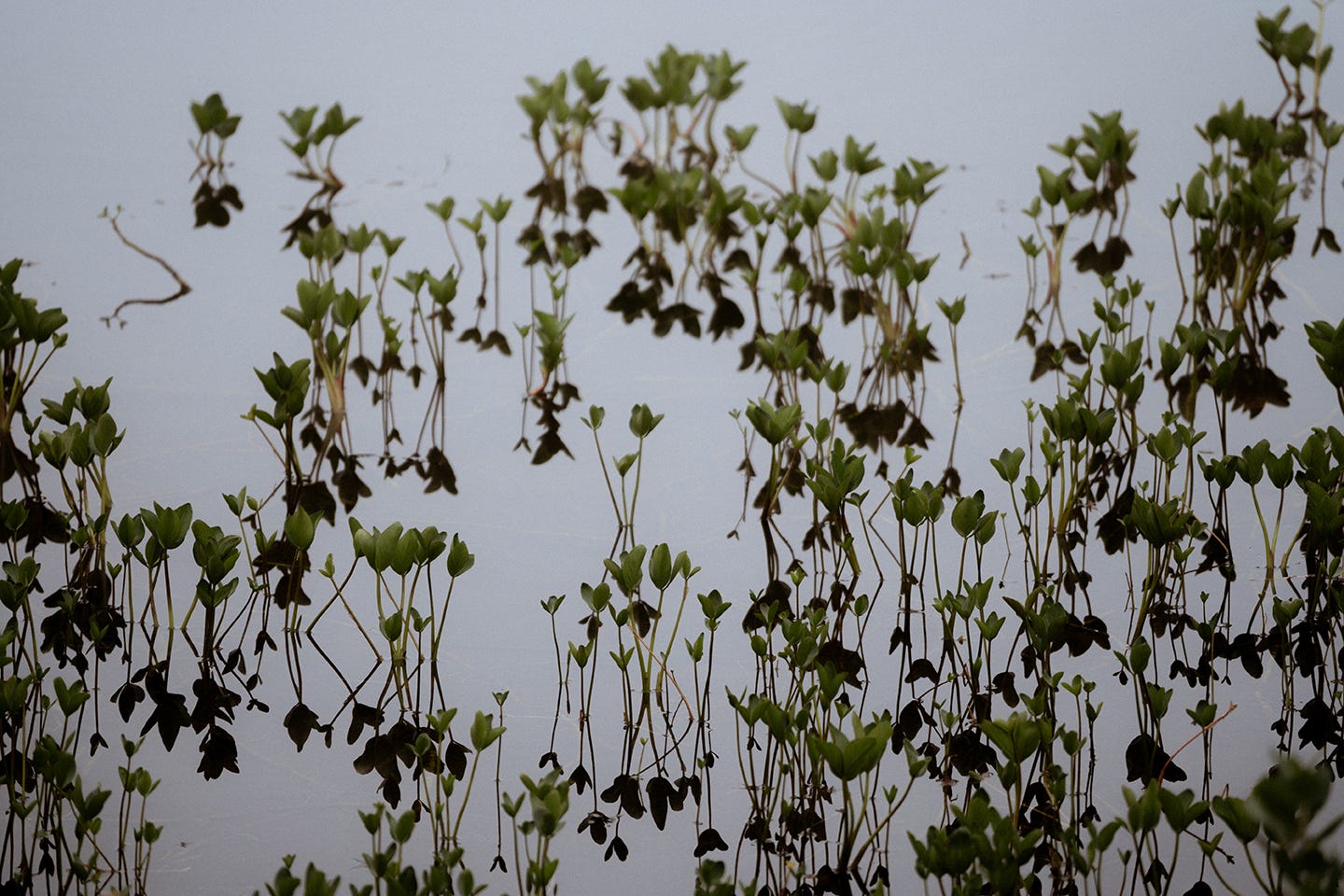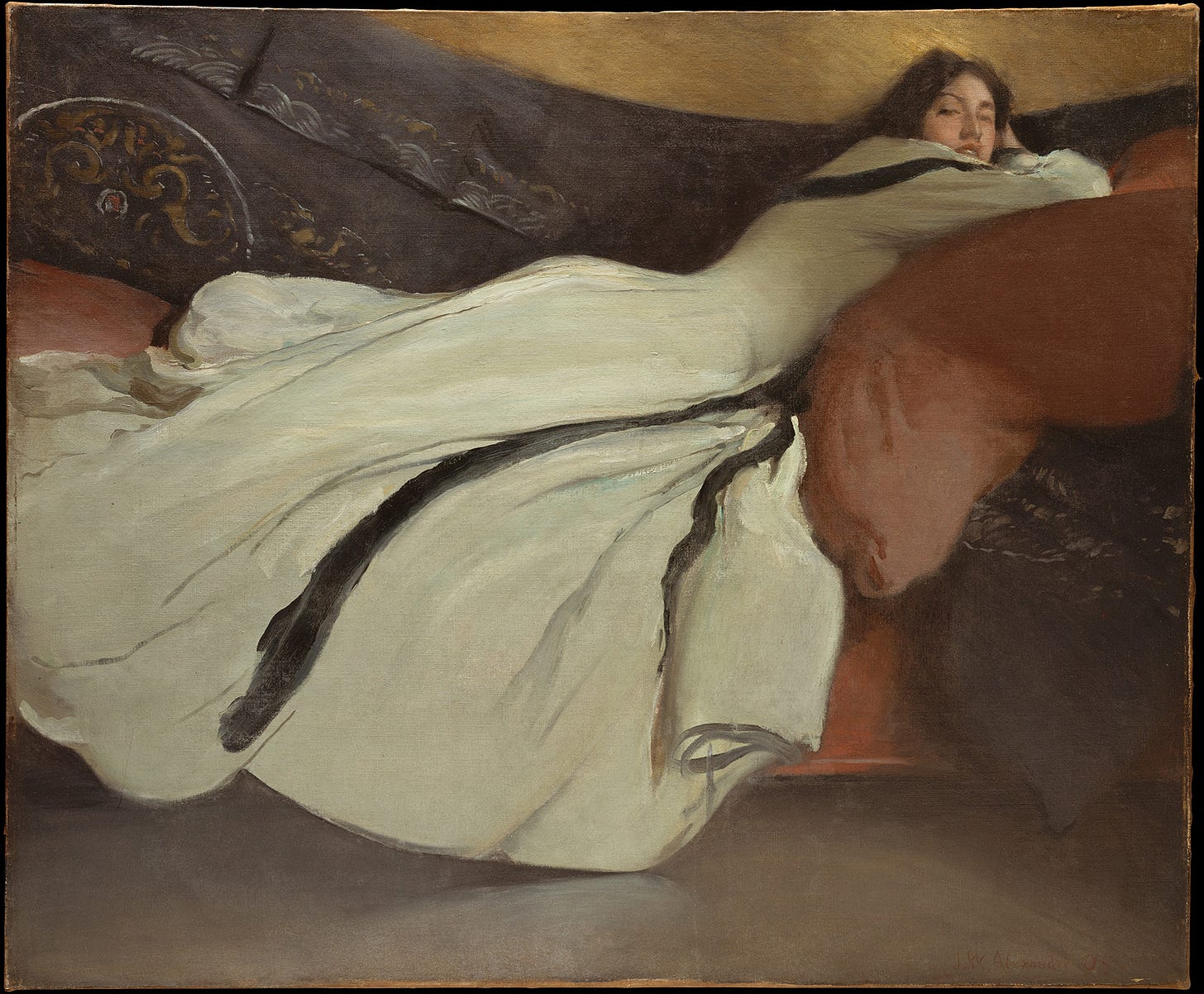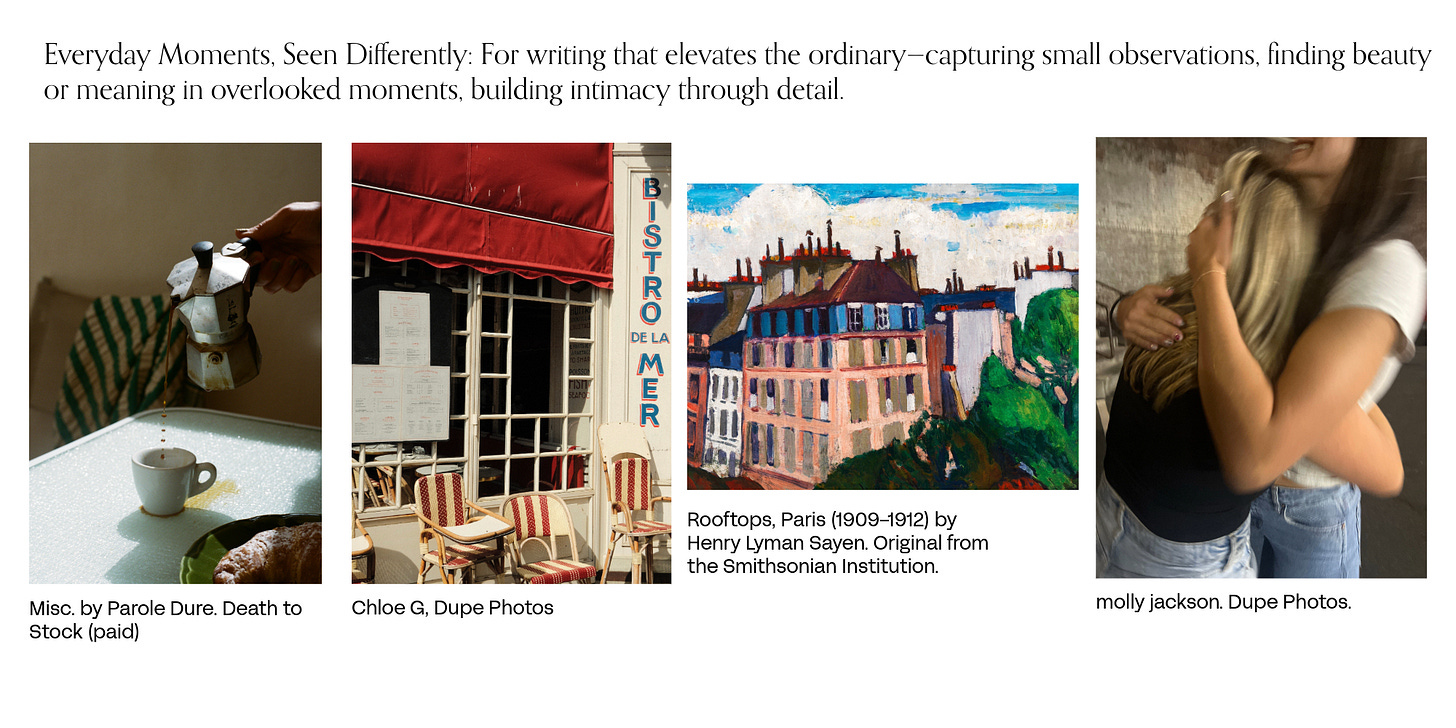Choosing images that expand your writing (not explain it)
Image resource bank + examples for building a visual story around your writing.
Your Images Are Part of the Story
When you share your writing online, the first thing readers encounter often isn’t your words, it’s the image.
Their eyes move faster than their minds.
Before they read a headline, before they register your name, they’ve absorbed something about the world you're offering them.
This isn’t a glitch in human attention. It’s visual hierarchy.
The brain sees before it reads.
That first image matters. It can shrink the space your words are trying to open—or it can expand it.
As a photographer, brand builder, and writer, I've lived inside this tension for years.
The image isn’t an accessory. It’s part of the first line of the story.
When we rush or default—slapping on a bandaid AI image, pulling a stock photo just to "make it look professional"—we miss a chance.
We shrink what could have been an invitation into something forgettable.
You don't need a perfect image.
You don't need an expensive camera.
You don't need to be a professional photographer.
What you need is something that feels intentional. A small image that hums in the same key as your words.
When I choose images for my own work, I rarely look for literal matches.
If I write about patience, I don't search for hourglasses.
If I write about creativity, I don’t look for lightbulbs.

Instead, I think about the feeling.
Sometimes, that means reaching into my own archive—photos from a walk in the forest, textures on a beach, a glimpse of something ordinary made strange by light.
Sometimes it means wandering through public domain archives, not hunting for a direct illustration, but waiting for an image to echo something emotional inside the work.
It's not always obvious why an image fits.
It's not supposed to be.
The photo doesn't explain the writing.
It expands it.
One of the unexpected joys of searching for images this way is how often it leads me somewhere new.
Art history sneaks in.
Old paintings, forgotten portraits, small works from less known photographers—sometimes the image finds me before the words settle.
Sharing these finds has become part of my practice.

A way to let the visual world and the written world meet without one overpowering the other.
The process reminds me that creativity isn’t linear.
That discovery matters as much as direction.
You don't have to be a professional to do this.
You don't need to stress about perfection.
You just have to notice.
The way the light falls across your desk.
The pattern of tide pools on a rainy beach walk.
The colour of dust kicked up by your own footsteps.
An imperfect photo, chosen with care, will always feel more alive than a flawless, soulless image designed to impress.
Professionalism isn't the goal.
Connection is.
I send out weekly thoughts on creativity, life, and slow process. If this resonates with you, consider becoming a free subscriber.
Now I want to show you what this looks like in practice. Not moodboards in the traditional sense—not dozens of tiny aesthetic matches—but a few standalone images grouped by feeling.
Each board gathers three or four pieces from different sources: museum collections, public domain archives, and artist-driven stock libraries. Some are paintings, some are photographs, some are fragments of history. They don't match each other perfectly. They aren't supposed to.
They simply live in the same emotional world.
You don't need polished perfection to find images that belong beside your work. You need attention. Curiosity. A willingness to look for feeling instead of facts.
Here's how that can look:
Image Resource Bank
Now, I do have my personal favourites when it comes to sourcing images, but I wanted to offer a wider list for anyone curious about where to look.
I often begin with places that gather work from many museums—browsing through Public.Work or RawPixel until something stops me—then I follow the thread back to the original museum to learn more about the piece and its history.
Since we're on Substack—a platform filled with incredible photographers and visual artists—it's also worth considering collaborations. Beyond sourcing from public domain and historical collections, you might find someone whose work resonates with your writing today.
Many artists are open to sharing a low-resolution (72 dpi) version of their work in exchange for a credit and link back. It's another way to build connections, honour living artists, and expand the visual world you're creating.
Before downloading or sharing any images, always double-check that they’re marked as public domain or open access. Most museums and archives make it very clear when a work is available for free use.
Public.Work (Public Domain, via original sources)
Beautifully organized collections from museums and archives—easy browsing with links back to originals.
RawPixel Public Domain Collections (Public Domain)
Clean, high-quality public domain selections—paintings, drawings, early photography.
Dupe Photos (Free, explicit permission)
Free-to-use, casual and authentic photography—great for modern, human-feeling visuals.
Public Domain Review (Public Domain)
Curated old book illustrations, photography, and vintage art—rich in literary and visual texture.
Unsplash (Free, with credit suggested)
Free modern photography—best for lifestyle, landscapes, and clean, simple visuals.
Death to Stock (Paid)
Creative stock photography made by artists—more soulful and story-driven than traditional stock libraries. Paid membership.
The Met Museum (Public Domain, many works)
Huge free archive of art across centuries—paintings, sculptures, objects, prints. Searchable and downloadable.
Rijksmuseum (Public Domain, many works)
Dutch museum offering thousands of high-res downloads of historic artworks—great for portraits, landscapes, and old still lifes. Always check individual works for download availability.
Smithsonian Open Access (Public Domain)
Millions of artworks, photographs, and objects from across all Smithsonian museums—including American Art, Air and Space, Natural History.
NYPL Digital Collections (Public Domain)
Old maps, photographs, manuscripts, posters—great for historical layering and creative projects.
Library of Congress (Public Domain)
Massive archive of historical photos, posters, maps, and documents—especially rich for American history themes.
NASA Image and Video Library (Public Domain)
Incredible archive of space photography—planetary landscapes, Earth views, and missions—all in the public domain.
Getty Museum Open Content Program (Public Domain, with light guidelines)
High-quality images of art, manuscripts, and sculpture—free to download and use under Getty’s Open Content policy.
Art Institute of Chicago (Public Domain, some works)
Beautiful, high-resolution artworks—many available under their Open Access policy for free download and use. Always check each artwork's rights information.
McCord Stewart Museum (Public Domain, some works)
Photographs, fashion, Indigenous collections, and Canadian historical imagery—many free for creative use (check item rights individually).
Adobe Express (Adobe Stock Free Collection) (Paid, via subscription)
High-quality photography and design assets accessible through Adobe Creative Cloud subscriptions—good for polished visual projects.
Hey, you made it to the end—so here’s a little secret:
I’m actually obsessed with Dupe Photos.
I think it's such a clever way to give a home to the kinds of images that might otherwise sit unseen—or worse, get stolen off places like Pinterest.
Not long ago, someone took a screenshot of one of my photos on Instagram and posted it as if I'd be grateful for the "credit."
I wasn’t.
It stung, especially because I do make some of my phone photos available for free on platforms like Dupe—specifically because I like to share.
And I have other work available for licensing through Stills, for those who want to support artists properly.
The screenshotted photo? It was one of the images available for purchase.
They could have asked. They didn’t.
That’s part of why this whole post has been simmering in my mind for a while.
There are so many ways to find art, to support artists, to build something beautiful without stealing.
Just because something is online doesn’t mean you can take it.
Anyway—I'm preaching to the choir, I'm sure.
Thanks for letting me get that off my chest.
P.S.
I'm thinking about sharing more creative challenges here — small ways to keep our creative energy feeling easy, regular, and connected.
Would you be interested?
And if you enjoyed this post, it would mean a lot if you'd consider sharing it or recommending my Substack.
Private notes are lovely—but helping more readers find this space makes a big difference too.
Thank you for being here.
visual storytelling | writing advice | public domain resources | creative process | pairing images with writing







I only just started here on Substack and we seem to have a very similar process for finding matching imagery. Sometimes it's hard though and is do end up picking a very literal image. Thank you for sharing all your sources. Not gate keeping these is a huge green flag. 🌟
Great points and resources!